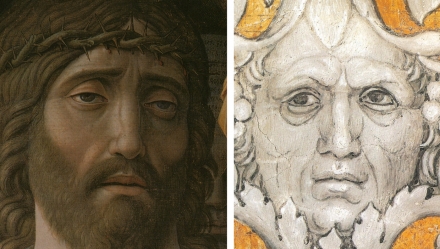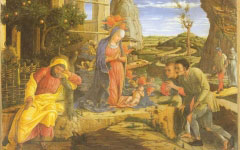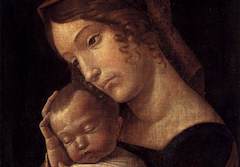Mantegna’s Ecce Homo (c.1500)

Mantegna, Ecce Homo (c.1500) Tempera on canvas. Musée Jacquemart-André, Paris
Click image to enlarge.
Mantegna's close-up depiction of Christ as Ecce Homo hangs in a small but charming museum in Paris in what was once a private collection. It is not well-known and it is worth a detour to see it. Dürer's Self-portrait as Christ, on the other hand, also dated 1500, is a virtual icon.
Click next thumbnail to continue
Dürer's image has so confounded interpreters that some deny that it depicts Christ at all. What sacrilege, they think, to paint oneself as Christ! Yet one only needs some familiarity with the Inner Tradition in any one of its many forms to know that mystics do not read the Bible as a historical story but as an allegory of an individual soul. We all have a divine spark and we are each made in the image of God. By purifying our souls, any one of us can become Christ and it is through reading scripture, literature and the arts allegorically that one can learn how to do so. It is art's prime purpose.
Click next thumbnail to continue
So while Durer was explaining how he as an artist can become Christ in northern Europe, Mantegna among others was relaying the same message to those who could see it in southern Europe.
Click next thumbnail to continue

L: Detail of Mantegna's Ecce Homo
R: Mantegna, Self-portrait detail as a green man
Click image to enlarge.
As far as I know no writer has ever noted that Mantegna's Christ (left), like Dürer's, resembles the artist's own self-portrait (right). Note the frown, the bags under the eyes, the apparently broken nose and the mouth. Mantegna makes it quite clear to those familiar with his work that he himself is Christ.
Click next thumbnail to continue
The two Jews who hold "Mantegna as Christ" have variations on the artist's face as well, both with deep bags under their eyes. One of them wears a turban, a form of headwear often used in the Renaissance studio to keep paint off one's hair. They are on one level the artist himself holding his "work of art", his "portrait" as Christ. On another level, they suggest to the budding mystic that as ordinary human beings our personality is divided. Once having passed through the suffering of life as Christ suffered the Passion, our divided soul can be purified and united in Christ.
More Works by Mantegna
Joseph, worth only a cameo appearance in the Bible, is a major star in visual art. Cast as a narcoleptic, he falls asleep in one image after another without any art historian, to my knowledge, pausing to ask: Why does he sleep so much?

Mantegna’s Adoration of the Shepherds (c.1450-51)
Notes:
Original Publication Date on EPPH: 10 May 2012. | Updated: 0. © Simon Abrahams. Articles on this site are the copyright of Simon Abrahams. To use copyrighted material in print or other media for purposes beyond 'fair use', you must obtain permission from the copyright owner. Websites may link to this page without permission (please do) but may not reproduce the material on their own site without crediting Simon Abrahams and EPPH.





